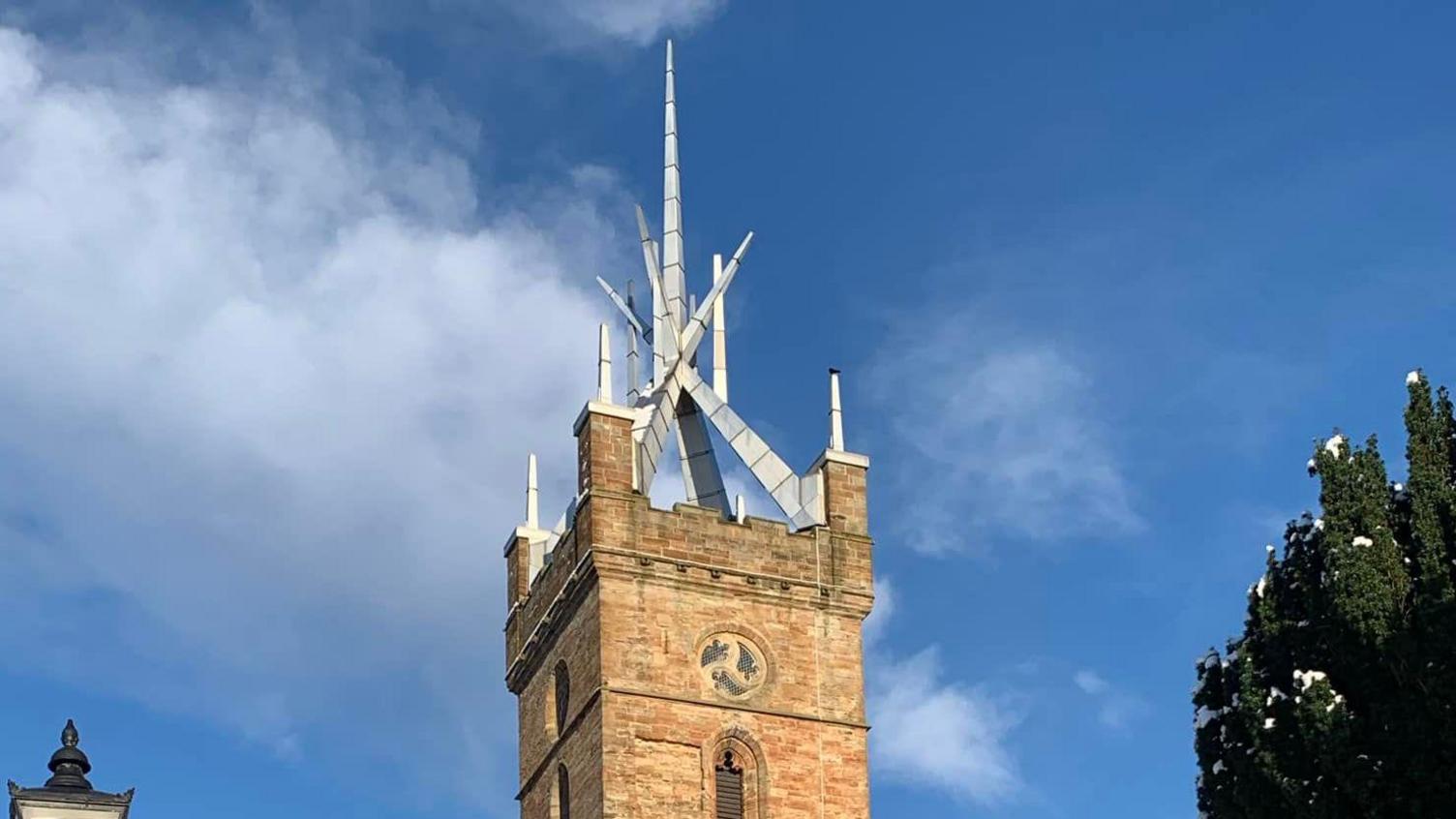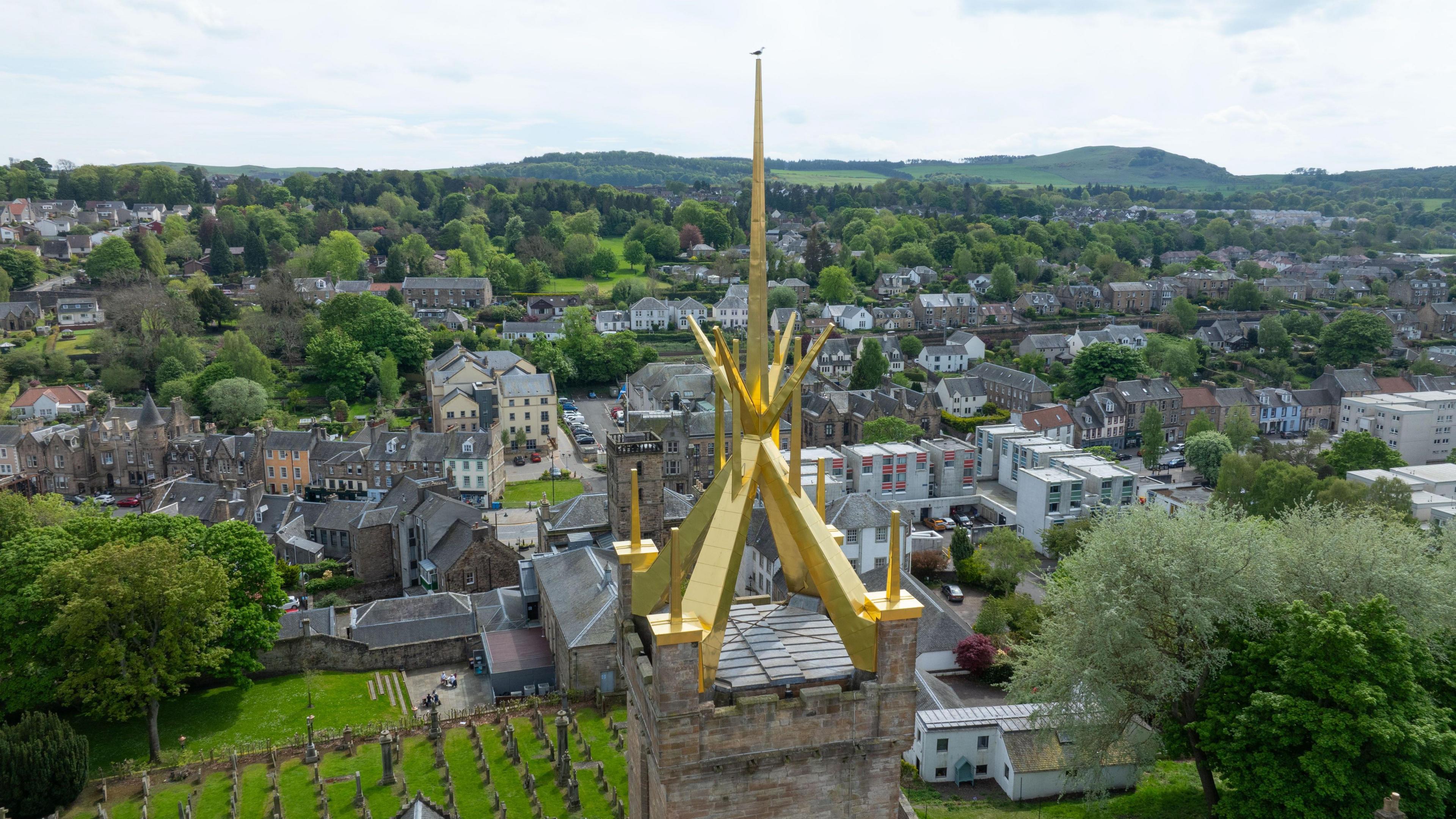Golden restoration for crown of thorns church spire

The spire has dominated Linlithgow's skyline for 60 years
- Published
A West Lothian church spire designed to look like Jesus' crown of thorns has been re-clad in its original gold colour.
The sculpture on St Michael’s Parish Church, where Mary Queen of Scots was baptised, has dominated the skyline in Linlithgow for 60 years despite controversy over its initial installation.
Weather damage later stripped it of its gleaming appearance and caused the timber insides to become unstable.
But work to repair the spire started last year after the community raised £220,000 to complete the restoration project.
St Giles': Playing a part in history for 900 years
- Published5 May 2024
Early Christian stone monuments on the move
- Published14 April 2024
Church as estate agent is a sign of the times
- Published22 January 2024
Retired architect Brian Lightbody, who led the project, said he hoped the spire would remain a "symbol" of the town for generations to come.
"Very few people can remember it clad gold," he told BBC Radio’s Good Morning Scotland.
"It has been dull grey for over 50 years and the cladding had become loose, letting water in and the timber structure was rotting.
"But the job has been remarkable. I think the fondness and the power of the crown in the town was reflected in the amount of money that people gave towards its restoration."
The church was initially built in the 15th century and featured a stone spire similar to that on St Giles' Cathedral in Edinburgh.
Mary Queen of Scots was baptised in the church shortly after her birth at nearby Linlithgow Palace in December 1542.
But by 1820 the original spire was removed over concerns the weight of the structure was destabilising the bell tower.
It remained without a top for more than 140 years until Reverend Dr David Steele contacted architect Sir Basil Spence for advice on a replacement as he felt the church looked “unfinished”.
Sir Basil suggested Mr Clarke as a suitable leader of the project, but his design did not originally go down well with church officials.

Weather conditions drained the spire of its colour
Mr Lightbody said: "It is an unashamedly modern work of art atop an important medieval building inspired by Christ’s crown of thorns.
"It was hugely controversial at the time. It had more detractors than supporters."
He said even the general trustees of the Church of Scotland refused to accept it as they believed it was too modern for the old church.
But the former architect added: "Rev Dr Steele believed the modernity was important to see for the church and its relevance to modern society."
Work on the spire began in September last year after a fundraising campaign.
Grant funding of £170,000 was added to the £220,000 raised by those in the town.
Initial inspection works revealed the interior structure, which is made from timber, had rotted due to water ingress and was at risk of collapse.
Mr Lightbody said the project was made "complex" by a combination of the spire’s height and adverse weather conditions.
It meant contractors were forced to find innovative solutions to keep the repairs on track.
He said: "When we looked at it, we realised if we didn’t fix it, it was going to collapse. We were building it through the worst of the winter.
"The timber repair contractor, his resins wouldn’t cure in any less than 5C (41F), so he invented all sorts of clever ways to keep it warm.
"The cladding contractor was unable to work in heavy rain, high winds and we had winds of over 90mph at one stage. It was a very intricate job."

The spire has been restored to its original gold colour
The church's current minister, Rev Dr Liam Fraser, said the spire had become a "beloved symbol of the town," and described the reaction to the completed project as "astonishing".
"The design was variously dismissed as a rocket, a wigwam or even left-over scaffolding," he said.
"But over time, it has come to be hailed as a masterful marriage of modern design to historic architecture.
"The church is here for today and tomorrow, not just yesteryear."